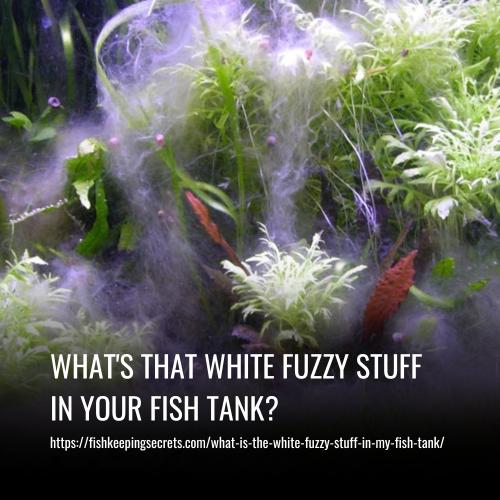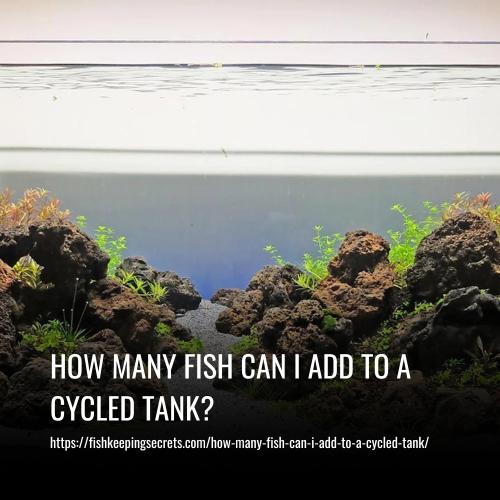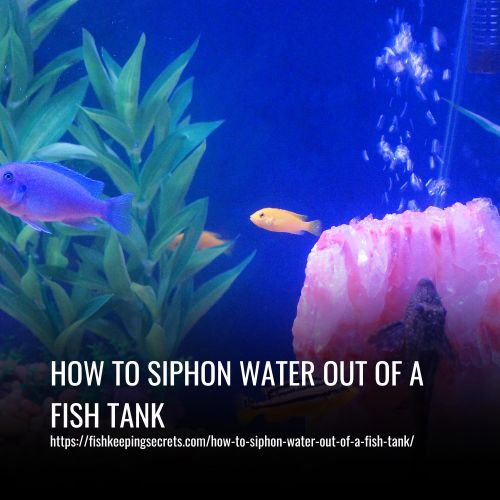The white fuzzy stuff in your fish tank is likely a type of fungus. Fungus thrives in moist and warm environments and can appear on various surfaces in your tank, including gravel, decorations, and even on your fish.
Maintaining a healthy and clean aquarium is crucial for the well-being of your fish. Regular water changes and proper filtration can help prevent the growth of fungus and other harmful bacteria. Overfeeding your fish can also contribute to the growth of fungus, as excess food can accumulate on the bottom of the tank and create an ideal breeding ground for bacteria.
If you notice fungal growth in your aquarium, it is essential to take proper action to prevent further spread and potential harm to your fish. In this article, we will discuss the different types of fungus that can appear in your tank, as well as various preventative measures and treatments to help keep your aquarium clean and healthy.

Causes Of White Fuzzy Stuff In Fish Tanks
White fuzzy stuff in fish tanks can be a headache for fish owners. It not only looks unsightly, but it can also be a sign of poor water quality that can negatively affect fish health and well-being. In this section, we will discuss the causes of white fuzzy stuff in fish tanks to help you understand why it occurs and how to prevent it in your aquarium.
1. Poor Water Quality:
Poor water quality is one of the most common causes of white fuzzy stuff in fish tanks. Here are some factors that can contribute to poor water quality:
- Overfeeding: Overfeeding leads to excess food waste and fish waste that can cloud the water, which promotes the growth of bacteria and fungus that appear as white fuzzy stuff.
- Lack of filtration: Without adequate filtration, uneaten food and fish waste will not be removed from the water, causing nutrient build-up that can contribute to the growth of white fuzzy stuff.
- Too many fish: Overstocking the tank can result in too much waste production and not enough filtration to handle it.
- Inadequate water changes: Infrequent or partial water changes can cause a buildup of toxins and waste in the water that can contribute to poor water quality and the growth of white fuzzy stuff.
2. Poor Aquarium Maintenance:
Cleaning your aquarium is essential to maintain a healthy environment for your fish. Poor aquarium maintenance can lead to the growth of white fuzzy stuff. Here are some factors that can contribute to poor maintenance:
- Lack of gravel cleaning: Gravel traps a lot of debris and uneaten food that can cause poor water quality and the growth of white fuzzy stuff.
- Infrequent water changes: Infrequent water changes do not remove enough waste and toxins, leading to poor water quality and the growth of white fuzzy stuff.
- Poor cleaning habits: Failing to clean surfaces like tank glass, decor, and equipment can lead to the growth of bacteria and fungus that appear as white fuzzy stuff.
3. Live Plants:
Live plants can be a beautiful addition to aquariums, but they can also be a cause of white fuzzy stuff. Here’s how:
- New plants: Newly purchased plants can introduce bacteria and fungus into the tank water that can cause white fuzzy stuff.
- Dead plant matter: Dead or decaying plant matter can cause poor water quality and the growth of white fuzzy stuff.
Understanding the causes of white fuzzy stuff in fish tanks is crucial to maintaining a healthy aquarium environment. By addressing these factors, you can prevent the growth of white fuzzy stuff, which can help keep your fish happy and healthy.
Types Of White Fuzzy Stuff In Fish Tanks
Fish tanks are an enigmatic and beautiful addition to any household. However, like any other living space, fish tanks can present various challenges for their inhabitants. One such issue is the growth of white fuzzy substances in the tank, which can be distressing for both the fish and their owners.
We will walk you through the types of white fuzzy stuff in fish tanks, including their causes, characteristics, and distinguishing features.
1. Fungal Growth:
Fungal growth appears white to the naked eye and occurs due to poor water quality and hygiene. It can grow on dead plant matter, uneaten fish food, and dead fish.
Key points:
- Fungal growth appears white.
- It occurs due to poor water quality and hygiene.
- It can grow on dead plant matter, uneaten fish food, and dead fish.
2. Bacterial Growth:
Bacterial growth is also white and can appear as a film or cloudy layer on the surface of the water. It forms when the water has high levels of organic waste, such as uneaten food, and dead plants or fish.
Key points:
- Bacterial growth is white and can appear as a film or cloudy layer.
- It forms when the water has high levels of organic waste like uneaten food and dead plants or fish.
3. Distinguishing Between Fungal And Bacterial Growth:
Distinguishing between fungal and bacterial growth can be difficult as both appear white. However, there are some distinguishing features:
- Fungal growth appears on solid surfaces such as fish or plant matter, while bacterial growth forms a film on the water’s surface.
- Fungal growth has a cotton-like texture, while bacterial growth is slimy.
- Fungal growth can be treated with over-the-counter anti-fungal treatments, while bacterial growth requires antibiotics.
Effects Of White Fuzzy Stuff On Fish And Tank Environment
White fuzzy stuff is a common problem that aquarium owners face, which can have detrimental effects on both the fish and the tank environment. Below are some of the key points to consider when dealing with white fuzzy stuff:
Explain How White Fuzzy Stuff Can Harm Fish And Impact The Tank Environment.
White fuzzy stuff typically appears on the surface of objects in the tank, such as plants, rocks, and other decorations. The presence of white fuzzy stuff can cause several negative effects:
- It can clog the fish’s gills, making it difficult for them to breathe.
- It may irritate the fish’s skin and fins, leading to disease or infection.
- The decomposing organic material can cause high levels of ammonia and nitrite in the water, leading to poor water quality.
- The white fuzzy stuff can spread rapidly throughout the tank, overtaking the healthy bacteria and disrupting the nitrogen cycle.
Discuss The Symptoms Of White Fuzzy Stuff That Fish May Exhibit.
It’s important to monitor the fish in the tank for any signs of distress or illness. Below are some of the common symptoms that fish may exhibit if affected by white fuzzy stuff:
- Difficulty breathing, gasping for air near the surface
- Erratic swimming behavior, darting or rubbing against objects in the tank
- Loss of appetite or refusal to eat
- Pale or discolored skin or fins
- Clamped fins or other signs of physical distress
Provide Examples Of Problems That White Fuzzy Stuff Can Cause In The Tank’S Ecosystem.
White fuzzy stuff can cause several problems in the tank’s ecosystem, affecting both the fish and the overall health of the environment. Some examples of these problems are:
- Harmful bacterial growth, leading to disease and infection among fish
- Unbalanced nitrogen cycle, resulting in high levels of ammonia and nitrite
- Poor water quality, leading to stress, illness, and death among fish
- A lack of beneficial bacteria, leading to further disruptions in the nitrogen cycle and overall tank health
It’s essential to address the issue of white fuzzy stuff in your fish tank as soon as possible to avoid any negative impact on the fish and the tank’s ecosystem. By monitoring your fish for symptoms and maintaining a clean and healthy tank environment, you can prevent the growth and spread of white fuzzy stuff and keep your fish happy and healthy.
Prevention And Treatment Of White Fuzzy Stuff In Fish Tanks
Prevention and treatment of white fuzzy stuff in fish tanks require a combination of proper maintenance and appropriate treatments. Here are some tips:
Outline Steps To Prevent The Growth Of White Fuzzy Stuff In Fish Tanks
Keeping a fish tank is a great hobby, but it comes with a lot of responsibilities. White fuzzy stuff, also known as fungal growth, is a common issue faced by fish owners. Here are some steps to prevent the growth of white fuzzy stuff in your fish tank:
- Regular water changes: Change at least 20-30% of the water in your tank weekly.
- Proper feeding: Overfeeding can cause uneaten food to decay, creating a breeding ground for fungus. Feed your fish only the amount they can consume in two minutes.
- Maintain a proper ph level: Fungus thrives in acidic water. Regularly test your water’s ph level and adjust it accordingly.
- Keep the tank clean: Regularly clean the tank and its accessories to prevent the buildup of excess organic matter.
- Introduce healthy fish: Quarantine new fish before putting them into the main tank to avoid introducing potential fungal spores.
Discuss The Treatment Options Available For Combating White Fuzzy Stuff In Fish Tanks
Despite the best efforts of fish owners, fungal growth can still occur. When it happens, prompt treatment is crucial to prevent the growth from spreading. Here are some treatment options to combat white fuzzy stuff in fish tanks:
- Salt treatment: Saltwater is a natural antifungal agent. Dissolve a teaspoon of aquarium salt per gallon of water and use it for a three-day treatment.
- Fungus medication: Over the counter anti-fungal medication is available at pet stores. Follow the instructions closely and adjust the dosage according to your tank size.
- Hydrogen peroxide: Hydrogen peroxide can be applied directly to the infected area using a pipette. Start with a low dosage and gradually increase if necessary.
- Clean the tank: Remove any organic matter in the water or on the items inside the tank.
Expert Tips Or Recommendations For Effectively Preventing And Treating White Fuzzy Stuff
Preventing and treating white fuzzy stuff in fish tanks requires a combination of knowledge, maintenance, and treatment. Here are some expert tips and recommendations for effectively preventing and treating white fuzzy stuff in fish tanks:
- Avoid stressing your fish: Stress can weaken a fish’s immune system, making it more susceptible to fungal growth.
- Keep the tank well-aerated: Fungus thrives in stagnant water. An air pump can be used to increase the oxygen level in the water.
- Observe and act quickly: Regular observation of your fish and their environment is crucial. Early detection can prevent the spread of fungal growth.
- Consult an expert: If in doubt, consult with a professional to diagnose the problem and help you treat it effectively.
Following these prevention and treatment options and expert recommendations will help you maintain a healthy and thriving aquarium. Remember, a clean and healthy environment is the key to happy fish.
FAQs
The white fuzzy stuff in your fish tank is most likely a fungus. This is common in new tanks or with overfeeding. Poor water quality is also a contributing factor.
To get rid of the fungus, you need to remove any uneaten food from the tank, check the temperature, and use a fungicide if necessary. Regular maintenance and cleaning of the tank can help prevent future occurrences.
While the fungus itself is not harmful to the fish, poor water quality caused by the fungus can be. High levels of ammonia and nitrites can be dangerous to fish, so it is important to eliminate the fungus quickly.
Conclusion
From the foregoing, it is evident that the white fuzzy stuff in your fish tank is a common phenomenon known as white mold or fungus. Though it may not be harmful to fish, it can signal environmental issues such as excess nutrients, improper lighting, or poor filtration.
It is essential to address the underlying causes of this issue to maintain a healthy aquatic environment for your fish. You can prevent further mold growth through regular water changes, proper cleaning of filters and tank walls, and maintaining proper water temperatures.



